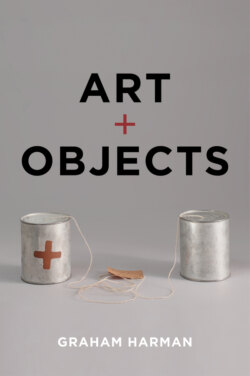Art and Objects

Реклама. ООО «ЛитРес», ИНН: 7719571260.
Оглавление
Graham Harman. Art and Objects
CONTENTS
Guide
Pages
Art and Objects
Abbreviations
Preliminary Note
Notes
Introduction Formalism and the Lessons of Dante
Notes
1OOO and Art A First Summary
Heidegger’s Insight: The Concealed and the Unconcealed
Husserl’s Insight: Objects and Qualities
Metaphor and its Implications
Notes
2Formalism and its Flaws
Beauty
The Sublime
OOO and Kantian Formalism
Notes
3Theatrical, Not Literal
Art and Objecthood
Theatrical Aesthetics
Adventures of Absorption
Notes
4The Canvas is the Message
Fried contra Greenberg
Background and Foreground
The Limits of Flatness
Notes
5After High Modernism
The Other “Bergs”
T.J. Clark vs. The Petty Bourgeoisie
Krauss: Background as Simulacrum
Rancière: The Distribution of the Sensible
Notes
6Dada, Surrealism, and Literalism
Literalism and Modernism
Dada and Literalism
Surrealism and Literalism
Conclusions
Notes
7Weird Formalism
Bad New Days
Five Implications
Notes
Works Cited
Index. A
B
C
D
E
F
G
H
I
J
K
L
M
N
O
P
Q
R
S
T
U
V
W
Z
POLITY END USER LICENSE AGREEMENT
Отрывок из книги
Graham Harman
Marcel Proust, À l’ombre des jeunes filles en fleur, p. 199
.....
In Chapter 4 (“The Canvas is the Message”) we turn to Greenberg, focusing on the limitations specific to his powerful way of thinking. Turning away from an increasingly academic tradition of illusionist three-dimensional painting, the modernist avant-garde had to come to terms with the essential flatness of its medium: that of the background canvas. This shift to the flat background has at least two consequences. The first is Greenberg’s consistent denigration of pictorial content, which he tends to dismiss as mere literary anecdote that continues to suggest an illusion of depth. The second, seldom if ever noted, is that the flatness of the canvas background medium is also treated as a oneness devoid of parts. On the latter point Greenberg has much in common with Martin Heidegger, that tainted but central philosopher, who often ridicules the surface of the world and its various visible entities as “ontic” rather than ontological. Heidegger also shows a nagging reluctance to conceive of Being as pre-dispersed into numerous individual beings, whose multiplicity he tends to portray as merely the correlate of human experience. It is Greenberg’s version of this prejudice that prevents him from grasping the importance of pictorial content.
Chapter 5 (“After High Modernism”) considers several of the most prominent ways in which the High Modernism championed by Greenberg and Fried has been rejected. I will focus here on those who do not play a significant role in other chapters of this book. Something should first be said about Harold Rosenberg and Leo Steinberg, two of Greenberg’s contemporaries, often portrayed as his rivals. I then turn to the more recent figures T.J. Clark, Rosalind Krauss, and Jacques Rancière; though of necessity my treatment of each figure can only give a rough indication of where my views differ from theirs.
.....